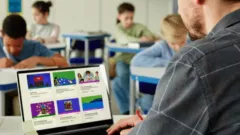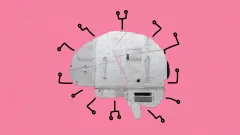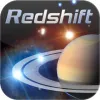Take a look inside 4 images
Redshift - Astronomy
Pros: Gorgeous graphics, a content-rich database, and the ability to view the current sky make a stellar astronomy experience.
Cons: The amount of information could overwhelm kids, and there's no way to assess learning.
Bottom Line: The app is a bit pricey, but it delivers a high-quality, in-depth look into the solar system.
Redshift - Astronomy would work well as a supplement to an astronomy or Earth and space unit. You could use the Follow Sky feature as a fun way to introduce a unit. Have kids point their devices toward the sky and discuss any stars or planets that appear. Ask kids to sketch what the sky might look like at night, and then have them do nighttime observations to try to identify what they saw during the day. You could also use the app as a resource for taking notes about the planets or other celestial bodies. For example, have kids use the Observatory or the 3D Flight feature to visit all of the planets and make a chart showing each planet's distance from Earth or each planet's magnitude.
Redshift - Astronomy is a comprehensive virtual planetarium that brings the universe to kids' fingertips. It includes 3D images of the solar system's 25 moons, more than 100,000 stars, 500 deep sky objects, 10 comets, and all of the major and dwarf planets. To start, kids can set up their home location and view the current sky using the Follow Sky feature, which relies on a built-in compass and sensors to find and identify stars. The Observatory feature gives an overview of objects in the solar system, and the 3D Flight feature takes kids on a digital journey through space to a star or planet of their choice. Kids can customize their experience using the many available settings. For example, kids can choose to show or hide constellations, turn grids on or off, or use sound effects like ocean or crickets to enhance the experience.
With so much information and so many customizable options, kids could get easily overwhelmed. Fortunately, there is an incredibly detailed help manual. Kids should spend some time reading this over before trying to use all of the app's features.
Kids can learn a lot about astronomy, including detailed information about all celestial objects. Each object's name, type, luminosity, size, and rise and set times are given. Kids can choose their home location using a GPS automatic search or by manually entering the location on Earth's globe.
Kids will feel empowered to learn at their own pace, and they will likely be intrigued by the ability to view a virtual image of the sky before them. The Follow Sky feature allows kids to study the current sky and identify stars and planets in real time. But the app misses a great opportunity to deepen the learning experience through guided instruction and assessment. Nonetheless, it's a great tool to help kids learn about astronomy and appreciate the vastness of outer space.











